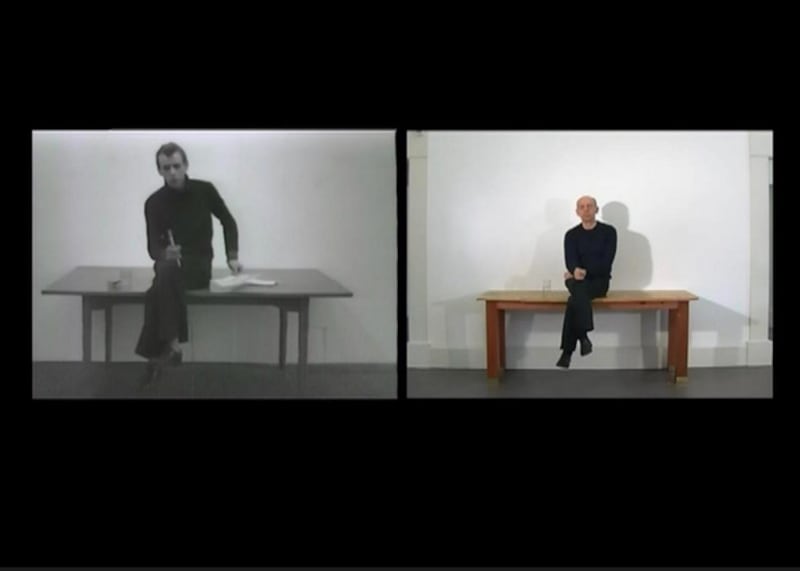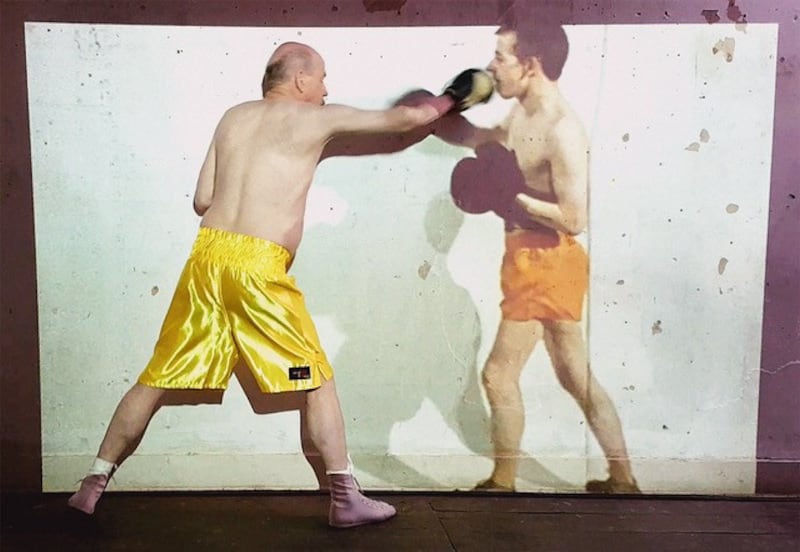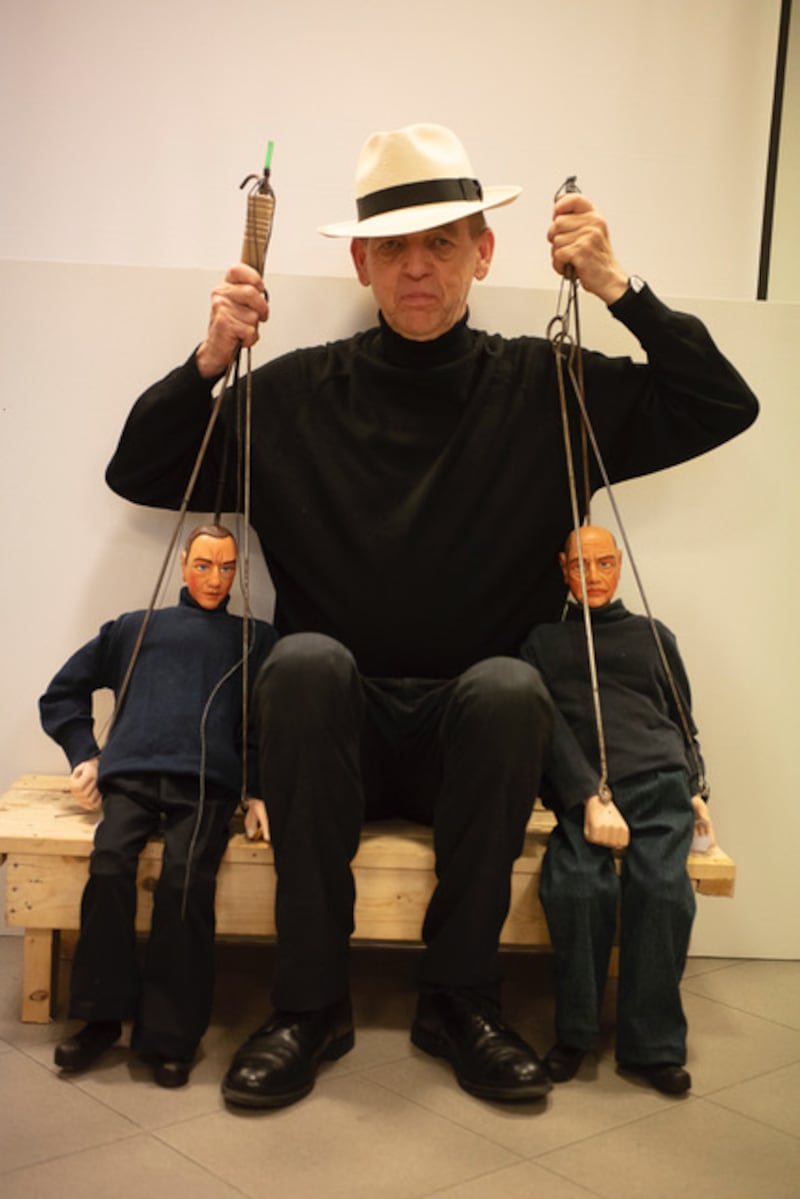There’s no such thing as reading, Vladimir Nabokov once decreed, only rereading. Kevin Atherton’s work, which often hinges on a perpetual revisiting of past moments, might seem to echo this idea for the visual arts. But not exactly. Probably his most famous piece, In Two Minds, began life in 1978 at the Project Arts Centre in Dublin, when the artist was 27. An ingenious video performance work, it involves the artist interviewing himself, interrogating what he is doing, inquiring what galleries are for and whether art needs an audience. Looking back, it recalls a heady era when emergent video art overlapped with conceptualism to engage variously and intensely with metaphysical, political and other questions.
In a real sense, In Two Minds is by design a perpetually unfinished work, an open question. Atherton has arranged and performed several iterations of the piece since, including dual-screen and live performance formats, in which the artist, progressively older on each occasion, engages with his 27-year-old self. It changes and evolves as the artist ages — and as the world changes; it is revisited or reread — but it is never the same. The one constant is that the questions do not vary.

Now a survey exhibition, The Return, at Kilkenny’s Butler Gallery features In Two Minds together with two other “early” works (the inverted commas acknowledge that the works are both early and, by their nature, not so early and open to revision and renewal), plus a 60-minute reel of collected video pieces. The show’s title refers not only to the circular processes enacted within the work, but also to Atherton’s return to Kilkenny, where he lived in Inistioge for many years. He moved to his present home, in Hastings in the UK, two years ago. “On the day I was leaving Ireland,” he says, “I got a phone call from Anna O’Sullivan at the Butler asking me if I would like to do this show.”
He was happy to say yes, not least, he mentions, because O’Sullivan’s curatorial standards are superb. And then: “After so long in Ireland, it was strange to return to the UK, especially as it is now. I really felt more connected to the Irish art world” (he became an Irish citizen). One of four siblings, Atherton is Manx by birth, and he grew up on the Isle of Man. His introduction to Ireland took the form of family holiday visits to Dublin, meticulously planned by his parents. The trips were, he recalls, calculated to benefit from whatever freebies the city might have to offer: visits to the Guinness brewery, the Players cigarette factory, Jacobs biscuits, each bringing their complimentary bounty. The dullest being the Irish Sweepstake. There, after a lengthy tour, the offering was “a little drinking glass embellished with your birth sign”. Over three years, his mother had schooled the children to modify their birth dates when asked so that they would build up a full set of 12 glasses. The ploy worked flawlessly.
READ MORE
He studied art, first on the Isle of Man, then Leeds, moving on to London. A spell at the Whitechapel presaged teaching positions at several colleges, including the Slade, the RCA and Chelsea, where he became a head of department. Over the years in London he encountered the late Noel Sheridan, who later became director of the National College of Art and Design (NCAD) in Dublin and he invited Atherton to take up — and indeed create — the post of head of media, which he did. Sheridan, a painter and performance artist, was a charismatic personality, a brilliant performer and a master of the non sequitur: “But if you stayed the course he always came back to the point, and it was usually worth waiting for. It might sound stereotypical, but in my experience, when Noel was external assessor at Chelsea, the English staff there, unlike the students, just didn’t get him.”
With its rigour and pared-down aesthetic, and its emphasis on language, the original version of In Two Minds could easily have been influenced by Beckett, but it wasn’t, at least consciously; “Flann O’Brien I was very enthusiastic about at the time.” Atherton has become more acquainted with Beckett since, and the connections with, particularly, Krapp’s Last Tape (he saw John Hurt’s performance), are strikingly evident to him, and may on some level have influenced the development of subsequent iterations. Pirandello is another useful referent. “People have asked me if it was part of my strategy that I would come back to it decades on in the way that I have, like laying down wine to drink in 20 years, but of course it wasn’t. I was living in a squat in London, I wasn’t thinking beyond the age of 30 at the most. It never entered my head that it would be this portrait in the attic.”
There’s also a misperception that “It’s all about me. I never thought of it like that, either. It has to do with the nature of the medium, with real time as opposed to theatrical time, with the way the world changes, and we change. As time went by, it was not the same me answering the questions”. He was reminded of that when a fairly hard-bitten technician was setting up a screening in Glasgow some years back. “I was explaining to him that the two individuals were both me, decades apart. He looked at the screen, then looked at me dubiously and remarked that I might want to tell the audience that.”
The nature of In Two Minds shaped Atherton’s development in that, for nearly a decade, he has been making work that incorporates or engages with early films and videos, an experience he has described as being like “standing on a moving Möbius strip where the past and present intertwine and become very complicated”. Another work, Signature Piece, centres on a 3D print in which Atherton signs a copy of himself as he was just minutes before: an artist signing his work.
The implications of the time lapse are quite dramatic in another piece, Boxing Re-Match, which spans 1972-2015. Instead of questioning himself, this time Atherton spars, kitted out in full boxing gear — “including yellow silk shorts” — with his considerably younger self, aged only 21. He memorised the choreography without much difficulty and the performance was recorded so that now we have two videos interacting, one within another and, as Atherton observes: “I always win.” The piece, like its companions, could be seen as a visualisation of the common experience of having two competing voices or views in your head, as one observer suggested.

In 2018, when he was teaching in Palermo in Italy, he collaborated with a puppet museum to produce a version of In Two Minds featuring two specially made 1m tall marionettes. They both represent him, of course, though the younger smokes, he notes, a flourish that entailed some ingenuity on the part of the puppet-master and is eerily effective. He’s keen to further explore working with the puppets: “To see what ideas they might come up with,” as he put it in one interview.

There’s a certain technical rawness to his work that is essential to its effectiveness. It depends on the authenticity of the material. If it was streamlined, say if the signs of its production were smoothed out by high-tech CGI, then it would lose a lot of its point. The layering of technology reflects the layering of time. Preserving that layering is in itself technically demanding, and he acknowledges the contribution of Anthony Hobbs, the photographer, who has worked with many artists and “who contributes so much more than technical skill” to his projects.
Artists do not really retire, and that is the case for him, though he has finished at NCAD. “It is one of those things,” he muses. “Now that I’ve stopped teaching, I feel I really know how to do it.”
The Return, Kevin Atherton at the Butler Gallery, John’s Quay, Kilkenny, August 6th-October 2nd butlergallery.ie













